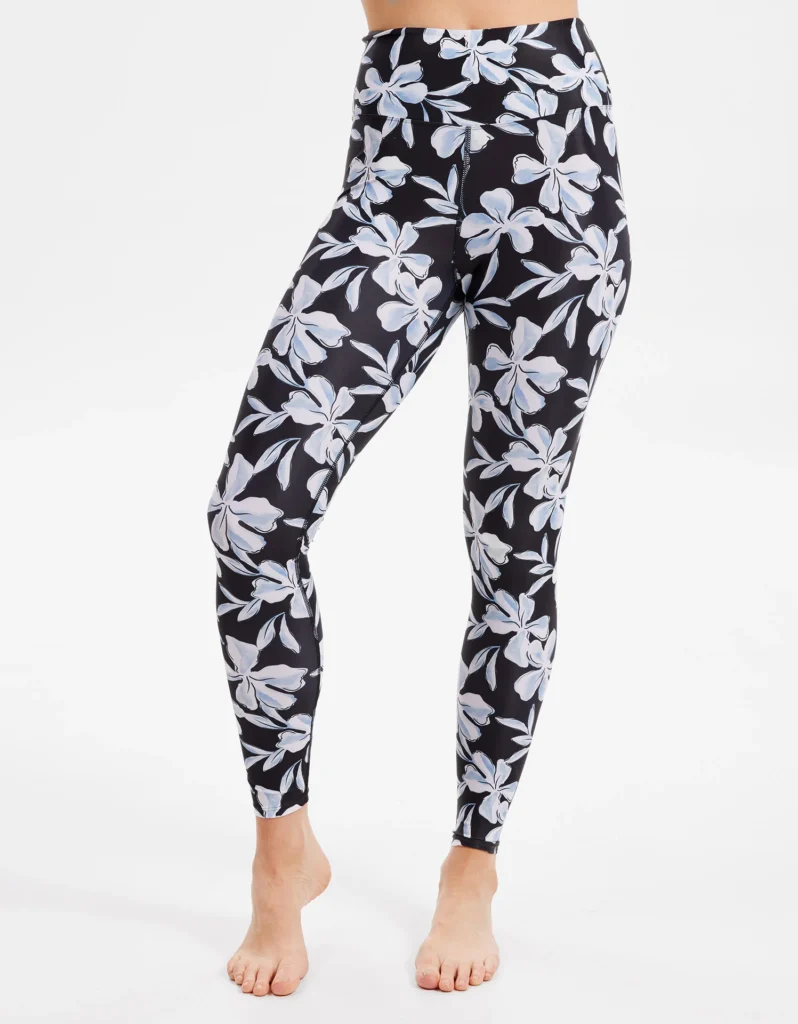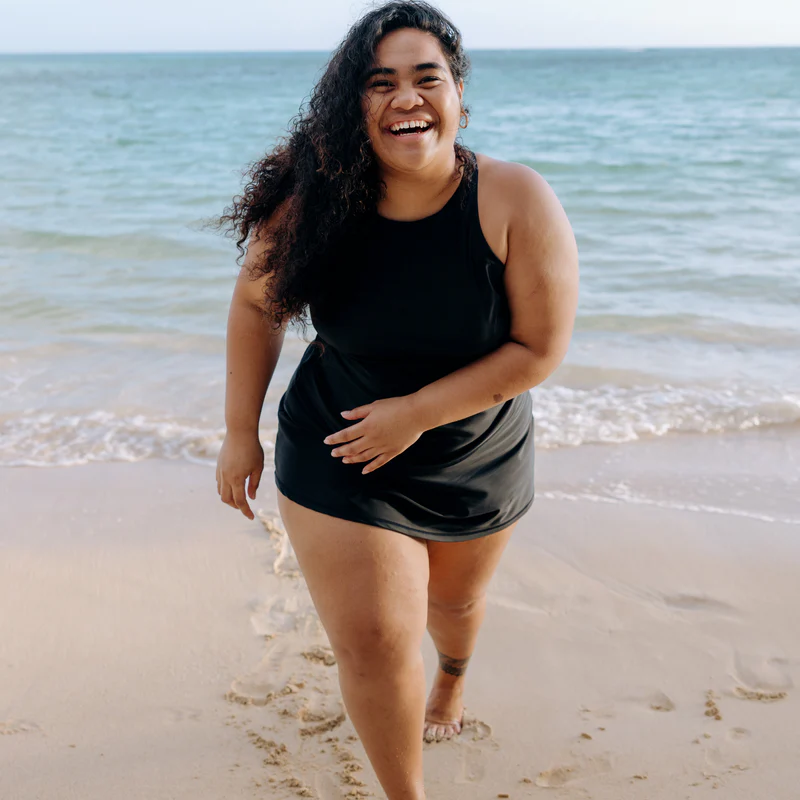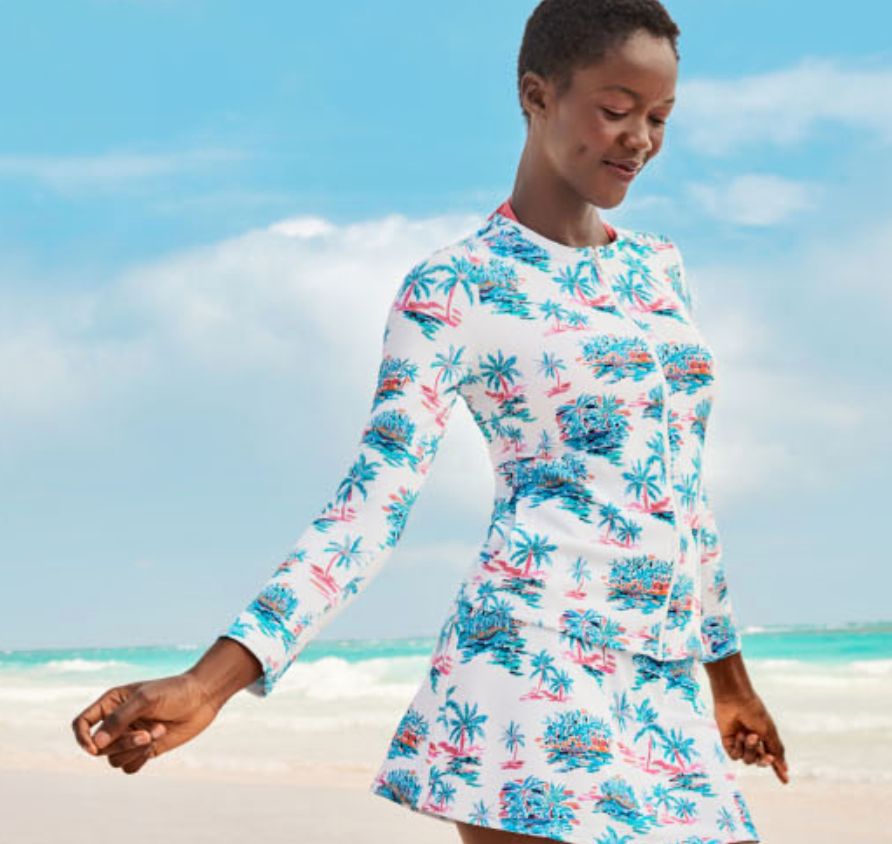It can be a tough choice on a sunny day whether to go to the beach or a swimming pool, but another choice is what kind of bathing suit to wear. In the last several years, new styles and fabrics for swimsuits give you more options to protect your skin.
How UPF Fabrics Can Protect Your Skin
Going swimming outdoors often means greater sun exposure. For those with fair skin or those who sunburn easily, even the best sunscreen may not block enough UV rays to prevent freckling and burning after an hour on the beach. What’s more, UV rays can penetrate through some clothing and swimsuit fabrics, so that even the skin covered by a bathing suit or clothing can be at risk.
The good news is that you can choose swimsuits that are made from UPF fabric that protects the skin underneath.
UPF means ultraviolet protection factor. UPF scores for fabric are different than SPF ratings for sunscreen lotions. A UPF 50 rating means the fabric blocks all but 1/50th, or 98% of the sun’s UV rays from reaching your skin. (SPF ratings for sunscreens measure the amount of time your skin can be exposed to UV light before reddening. A lotion that is SPF 15 means it may be possible for you to stay out in the sun 15 times longer. Unlike UPF ratings that measure both UVA and UVB rays, SPF is based only on UVB rays.)
For extra protection, you can also choose suits that cover more of your skin — like swim pants or long-sleeved swim tops in UPF fabrics. Another option is to wear a rash guard over your existing swimsuit. Rash guards are UPF tops or bottoms made to wear over your suit that you can wear in or out of the water.
Examples of Sun-Protective Swimsuits and Rash Guards
Here are examples of sun-protective swimsuits and rash guards that have earned the Skin Cancer Foundation’s “Seal of Recommendation.” A fabric must be at least a UPF 30 to qualify for the seal.
For example, here is a long-sleeve swimsuit and matching swim pants, which both are made from UPF 50+ fabric. You can get both the protection from covering a large area of skin plus a UPF fabric that blocks 98% or more of the sun’s UV rays (both are by solbari.com).


There are also standard swimsuit styles created with UPF 50+ fabrics, when you want to be sure that even the skin underneath your bathing suit is protected. There are suits available for the whole family, and for plus sizes, too. (The items below are from swimzip.com).


Below are some examples of UPF rash guards. A rash guard shirt may be a good item to toss in your beach bag for when you think your skin may have had enough sunshine (the items below are from tommybahama.com).


To shop for more swimsuits and clothing that have earned the Skin Cancer Foundation’s seal, check out their recommended products page.
UPF Coverage Helps Manage Other Skin Conditions
If you are suffering from a skin condition like psoriasis, vitiligo, or severe acne on the chest or back, you may have avoided donning a bathing suit in the past. It’s understandable that you might feel shy about exposing areas of patches, scarring, or plaques — even though there is no other reason for you to stay out of the water. A suit that covers more of your body, or wearing a rash guard over your suit, might help. It can give you the confidence you need to go have fun, and reduce your worry about embarrassment.
Others suffering from rosacea, TSW, or red skin syndrome, often find that sunshine can trigger a flareup. Covering the skin with a UPF bathing suit or rash guard can often help.
Some people just cannot tolerate the ingredients in sunscreen, or strongly dislike the sensation of sunscreen on their skin. Rather than go without protection, why not try a fabric barrier for protection? A suit or rash guard that covers more skin and is made of UPF fabric is a great choice.
There are also those who have skin that is sensitive to or triggered by shaving. The good news is that you can find swimsuits that cover your underarms, legs or back, if you feel self-conscious about not being able to shave those areas.
New Styles Cover More Skin Fashionably
The great thing about new swimsuits and rash guards with UPF fabrics is that they are good-looking and stylish! With so many people participating in a wider range of water activities these days, it’s not unusual to see people at the local pool in full wetsuits, or long-sleeve swim tops and pants.
If you shop around, you’ll find a variety of styles in UPF beachwear that cover you fashionably while helping protect your skin from the sun’s rays. You can even mix or match tops and bottoms to change up your style, and/or cover the areas on your body that you choose.
Conclusion
New UPF fabrics give options to those who’ve avoided swimming and water activities due to skin cancer risk or skin vulnerability that can come with a chronic skin condition. Look for the Skin Cancer Foundation Seal of Recommendation on the next swimsuit you buy, and consider adding UPF clothing to your pool or beachwear wardrobe.
Want to Learn More About Skin Health
Click HERE to get the Amethyst Holistic Skin Solutions Newsletter. You’ll receive interesting information about skin health via articles, before/after pictures, case studies of Amethyst patients, videos, interviews and more. Feel free to share this article with someone who you think may benefit.
About the Author
Olivia Hsu Friedman, LAc, Dipl.OM, DACM, Cert. TCMDerm, is the owner of Amethyst Holistic Skin Solutions and treats Acne, Eczema, Psoriasis, and TSW. Olivia treats patients via video conferencing using only herbal medicine. Olivia is Chair of the Board of Directors of the American Society of Acupuncturists, serves on the Advisory Board of LearnSkin, and is a faculty member of the Chicago Integrative Eczema Group sponsored by the National Eczema Association.



